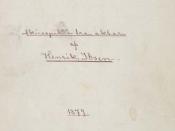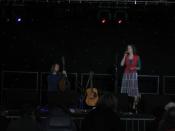Characterization of Corruption:
Welcome to A Doll's House
Henrik Ibsen's controversial play A Doll's House serves as a critical analysis of society, using rich characterization to illustrate the effects of human corruption. The characters include Nora, a repressed housewife who ultimately abandons her children after realizing that her life no longer represents who she is. Nora's husband Torvald is the proverbial poster-boy for the patriarchal society of 1870's Norway, and has been slowly and steadily alienating his wife with his dominating personality and chiding remarks. Another character is Mrs. Linde, a widow who married a man she never loved for financial stability after her father's death left her penniless. Doctor Rank, a great friend of Nora and Torvald, grew up sickly, diseased before conception after his father received syphilis from one of his many mistresses. Finally, the character Krogstad suppressed a crime and is now a bad example for his children.
In his play A Doll's House, Ibsen creates characters with different backgrounds to portray various facets of human corruption.
At the beginning of the play, Nora's character is like that of a young child. She is submissive to her husband as she was with her father and is thus oppressed by her environment. "Her childishness creates her charm, her danger, and her destiny"(Salom , 42). Nora feels trapped by the way men have treated her, and now her husband has replaced her father's role as an overbearing parent. Even still, her love for each of them has kept her from ever leaving. "'When I lived at home,' Nora told Dr. Rank, a frequent visitor, 'naturally, I loved father above all else.... You can well imagine that being with Torvald is just like being with father'"(Salom , 42)." Throughout the play, Nora seems to be the only character who...


